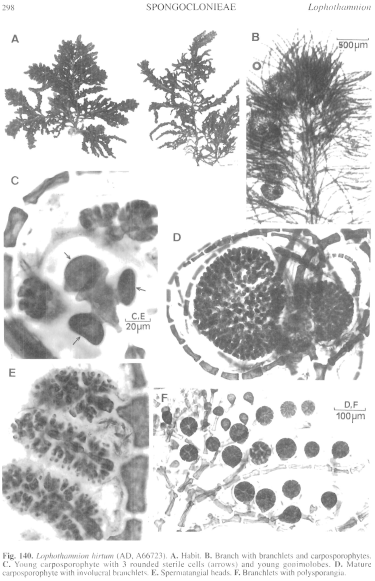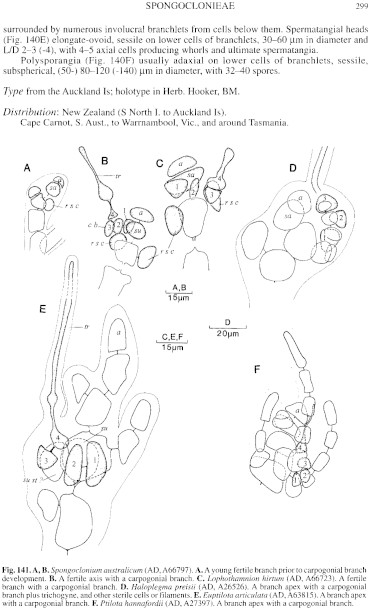|
|
|
|
|
|||||||||||
|
Electronic Flora of South Australia Species Fact Sheet
Phylum Rhodophyta – Order Ceramiales – Family Ceramiaceae – Tribe Spongoclonieae
Synonyms
Callithamnion hirtum Hooker & Harvey in Harvey & Hooker 1845: 192, pl. 78 fig. 2.
Pleonosporium hirtum (Hooker & Harvey) Laing 1905: 393, pl. 27 fig. 1. Adams 1994: 252, pl. 93 upper right.
Lophothamnion comatum J. Agardh 1892: 43.
Pleonosporium ?comatum (J. Agardh) De Toni 1903: 1309. Lucas 1909: 49; 1929a: 24.
Thallus (Fig. 140A) erect, flaccid, dark red-brown, 5–15 cm high, densely and irregularly spirally branched (Fig. 140B) with one to several main axes and prominent lateral branches with dense rhizoidal cortication on mid and lower axes (1–2.5 mm in diameter) and laterals; ecorticate lateral branchlets spirally arranged, 1–2 mm long, with long, curved, unbranched terminal branches. Holdfast conical, rhizoidal, 2–25 mm across; epilithic. Structure. Axial cells 50–60 µm in diameter and L/D 1.5–2 above, increasing to 200–300 µm in diameter and L/D 1–2 (–4) below. Lateral branchlets basally branched 1–5 times with long ends tapering only slightly, (20–) 30–50 (–60) µm in diameter with cells L/D (1–) 1.5–2 (–3), terminal cells with rounded ends. Cells multinucleate; rhodoplasts discoid, densely aggregated.
Reproduction: Gametophytes dioecious. Carpogonial branches (Fig. 141C) of 4 small cells, on the subterminal cell of short, 3-celled lateral branches and the third cell bearing two sterile periaxial cells; post-fertilization the 3 sterile cells enlarge and become rounded (Fig. 140C) and the auxiliary cell produces 1–4 successive rounded gonimolobes (Fig. 140D) 200–600 µm across of ovoid carposporangia (10–) 20–50 µm in diameter; carposporophytes become surrounded by numerous involucral branchlets from cells below them. Spermatangial heads (Fig. 140E) elongate-ovoid, sessile on lower cells of branchlets, 30–60 µm in diameter and L/D 2–3 (–4), with 4–5 axial cells producing whorls and ultimate spermatangia.
Polysporangia (Fig. 140F) usually adaxial on lower cells of branchlets, sessile, subspherical, (50–) 80–120 (–140) µm in diameter, with 32–40 spores.
Type from the Auckland Is; holotype in Herb. Hooker, BM.
Selected specimens: Cape Carnot, S. Aust., upper sublittoral, shaded (Womersley, 8.i.1951; AD, A15097). O'Sullivan Beach, S. Aust., 0.5 m deep (Clarke & Engler, 25.xi.1978; AD, A53965). Port Elliot, S. Aust. (Hussey, Oct. 1898; AD, A36051). Cape du Couedic, Kangaroo I., S. Aust., lower eulittoral (Womersley, 12.i.1948; AD, A7006). Robe, S. Aust., low eulittoral (Womersley, 27.x.1996; AD, A66723 - "Marine Algae of southern Australia" No. 366a). Cape Northumberland, S. Aust., lower eulittoral (Womersley, 8.xii.1991; AD, A61557 - "Marine Algae of southern Australia" No. 366). Lawrence Rock, Vic., in rock pools (Beauglehole, 13.i.1954; AD, A20524). Bridgewater Bay, Vic., rock pools (Womersley, 28.i. 1964; AD, A27422). Warrnambool, Vic., lower eulittoral (Pope & Bennett, 16.viii.1949; AD, Al2124). Green Point, Marrawah, Tas., lower eulittoral (Bennett, 29.i.1955; AD, A20624). Binalong Bay, Tas., on reef (Wollaston & Mitchell, 3.iii.1964; AD, A27939). Bicheno, Tas., in pools (Bennett, 6.ii.1955; AD, A20674). Southport, Tas., on rock platform (Wollaston & Mitchell, 27.ii.1964; AD, A27709). Catamaran, Recherche Bay, Tas., upper sublittoral (Wollaston & Mitchell, 27.ii.1964; AD, A27742).
Distribution: New Zealand (S North I. to Auckland Is).
Cape Carnot, S. Aust., to Warrnambool, Vic., and around Tasmania.
Taxonomic notes: There is no apparent difference between the Australian L. comatum and the earlier named C. hirtum from the Auckland Is, now well known from the southern part of New Zealand and common in the lower eulittoral on Stewart I.
J. Agardh (1892, p. 43) gave "australes Novae Hollandiae et Tasmaniae" as the original localities for L. comatum, and in LD are specimens from Port Fairy, Vic., and Orford, Tas. (Meredith), as well as ones from Port Elliot, S. Aust. (Hussey) probably received after the original description. A Port Fairy specimen is selected as lectotype, with two isolectotypes.
L. comatum is a common species on lower intertidal rock, especially from Robe eastwards and eastern Tasmania.
References:
ADAMS, N.M. (1994). Seaweeds of New Zealand. (Cant. Univ. Press: Christchurch.)
AGARDH, J.G. (1892). Analecta Algologica. Acta Univ. lund. 28, 1–182, Plates 1–3.
DE TONI, G.B. (1903). Sylloge Algarum omnium hucusque Cognitarum. Vol. 4. Florideae. Sect. 3, pp. 775–1521 + 1523–1525. (Padua.)
HARVEY, W.H. & HOOKER, J.D. (1845). The botany of the Antarctic Voyage of H.M. Discovery Ships Erebus and Terror in the years 1839–1843. I. Flora Antarctica. Part I. Algae, pp. 175–193. Plates 69–78.
LAING, R.M. (1905). On the New Zealand species of Ceramiaceae. Trans. Proc. N.Z. Inst. 37, 384–408, Plates 24–31.
LUCAS, A.H.S. (1909). Revised list of the Fucoideae and Florideae of Australia. Proc. Linn. Soc. N.S.W. 34, 9–60.
LUCAS, A.H.S. (1929a). The marine algae of Tasmania. Pap. Proc. R. Soc. Tasm. 1928, 6–27.
The Marine Benthic Flora of Southern Australia Part IIIC complete list of references.
Publication:
Womersley, H.B.S. (24 December, 1998)
The Marine Benthic Flora of Southern Australia
Rhodophyta. Part IIIC. Ceramiales – Ceramiaceae, Dasyaceae
©State Herbarium of South Australia, Government of South Australia
Illustrations in Womersley Part IIIA, 1998: FIGS 140, 141C.

Figure 140 enlarge
Fig. 140. Lophothumnion hirtum (AD, A66723). A. Habit. B. Branch with branchlets and carposporophytes. C. Young carposporophyte with 3 rounded sterile cells (arrows) and young gonimolobes. D. Mature carposporophyte with involucral branchlets. E. Spermatangial heads. F. Branchlets with polysporangia.

Figure 141 enlarge
Fig. 141. A, B. Spongoclonium australicum (AD, A66797). A. A young fertile branch prior to carpogonial branch development. B. A fertile axis with a carpogonial branch. C. Lophothamnion hirtum (AD, A66723). A fertile branch with a carpogonial branch. D. Haloplegma preisii (AD, A26526). A branch apex with a carpogonial branch plus trichogyne, and other sterile cel Is or filaments. E. Euptilota articulata (AD, A63815). A branch apex with a carpogonial branch. F. Ptilota hannafordii (AD, A27397). A branch apex with a carpogonial branch.

|
Email Contact: State Herbarium of South Australia |

|